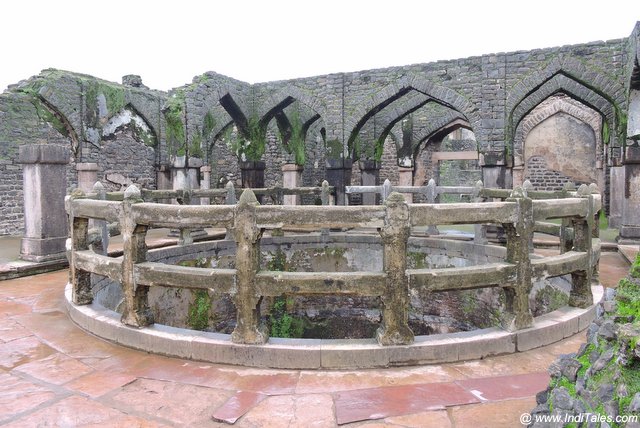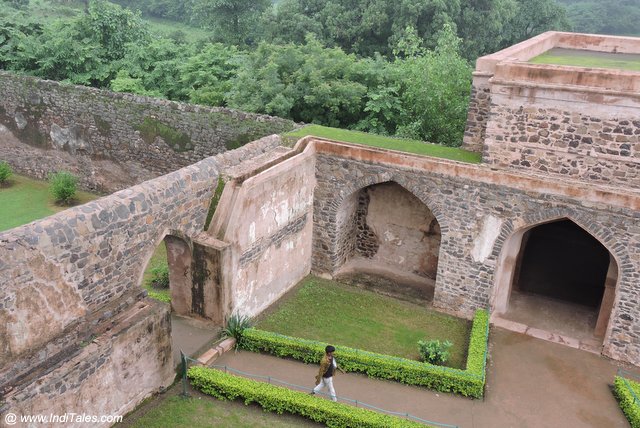Mandu is located on a hill at an elevation of more than 2000 feet on the Vidhya ranges with the Malwa plateau to its north and Narmada Valley to its South. There is no natural source of water here. The Narmada is too far to nurture it with her waters. Getting her water to 2000+ feet levels would literally be an uphill task in the days of non-motorized systems. The hilltop means no groundwater. So how did people live on this hill for thousands of years? Well, they had an incredible water management system at Mandu in place. You can still see them in some shape, and believe me, each water management point will pleasantly surprise you.

Water Management, Harvesting & Conservation – Mandu Points of Interest
The water Management System at Mandu comes in the form of 1200 tanks of different sizes and shapes. Most of them are still intact and if you go during monsoons, you can see them full of water. Let’s look at some of the interesting water bodies of this heritage place.
Lakes & Baodis in Mandu Fort Royal Complex
Jahaj Mahal

This elongated palace surrounded by two man-made lakes gets its name for two reasons. One its shadow makes it look like a ship. The second and the more important reason is that when the lakes on both sides are full, the palace feels like floating in a sea. You can only imagine the focus on water management in Mandu in the name itself.
Roaming around the royal complex, at every step you either meet a water body or a water channel that is aesthetically intrinsic to the design of the palace.
Munj Lake & Kapoor Lake
As you enter the Jahaj Mahal complex, on your left is the palace with Munj Lake behind it, and on the right is Kapoor Lake with many water channels leading to it.

Kapoor Lake has walk-in pavilions that make you feel you can literally walk into the lake. The Munj lake, on the other hand, has a Jal Mahal or a water palace inside it and a swimming pool next to it. Munj Lake was built by a king called Munjdev and is the older and larger of the two lakes. It is open on one side while touching the base of the Jahaj Mahal on one side. Kapoor Lake has embankments on all sides making it a closed lake.

Two swimming pools one in the shape of a Koorma or Tortoise and the other in the shape of a flower are a part of the Jahaj Mahal. Located at two different levels, these are the best examples of how you can integrate the aesthetics with the practical needs of the water. What amazes me is that they could not only store water well but channel it in such a way that they could easily afford a water luxury like swimming pools.

The swimming pool on top has channels with curvaceous designs leading to the pool. It is such a lovely way to channel the water. Our guide told us that these channels were filled with sand to filter the water. Some other resources say that channels helped slow down the flow of water into the pool. Whatever may be the reason, I hope our modern architects learn from these aesthetics.
Champa Baodi

This is a unique well that I have seen anywhere. It is a usual large well, fed by rainwater. The inside of Champa Bavdi is square while its wall is round with niches in it. The innovation lies in building multiple stories of living apartments surrounding this round wall. Believe it or not, there are four stories of living quarters of the palace surrounding this. The final level is almost at the level of Munj Lake.
The buildings stay cool because of the Baodi next to them. The long corridors allow the circulation of air. What an intelligent way to store water and make it work as an eco-friendly air conditioner.
The name Champa comes from the fact that this Baodi was surrounded by Champa or Magnolia trees. Can you even imagine the air being made fragrant naturally?
Ancient Hindu Baodi
Opposite the Jahaj Mahal lies a deep and steep Baodi and the board says ancient Hindu Baodi. My guess is that this stepwell belongs to the times of Parmar Kings or maybe even earlier. I assume there may have been a temple attached to this Baodi.
Ujala Baodi – Andheri Baodi

These are twin Baodis located at a short distance from the Jahaj Mahal complex. In fact, they are located close to an erstwhile market complex. Ujala Baodi is so-called as it is located in the open, while Andheri Baodi is located in the dark.
Read More – Stunning Chand Baodi of Abhaneri
Ujala Baodi is beautiful and its geometric steps reminded me of Chand Baodi in Abhaneri. The steep steps lead to the base of the Baodi. It looks beautiful from the gazebo-like pavilion on its sides. I could imagine evening gatherings around Ujala Baodi.
Baz Bahadur Palace – Water Management System at Mandu
Baz Bahadur palace is rather secluded close to the ancient Rewa Kund. Rewa Kind itself is fed by the underground springs that are believed to be connected to the Narmada.

While you can get lost in the love story of Baz Bahadur and Rani Roopmati, the place is all about collecting every drop of water. Do not forget to look at the top of the palace walls – all of which have water channels that collect rainwater and channel them to the tank in the middle. At one place where the wall discontinues due to a door, the channel goes underground and then comes up again at the other end of the door. Incredible!
Read More – Queens Trail in MP – Mandu, Maheshwar & Burhanpur
The tank is symmetrically placed in an open courtyard with a royal pavilion on one side and a musician’s pavilion on the other looks beautiful.

Before you think this was just plain aesthetics, wait. Water was even used to smoothen the musical notes of music being produced in acoustic halls of the palace of Baaz Bahadur. The sound waves as they traveled from the musician’s pavilion to the royal pavilion full of connoisseurs of music traveled over water and any jarring notes were smoothened.
Rani Roopmati Mandap or pavilion looks like an outpost overlooking the fort walls and surrounding regions. However, this also has a long underground water tank collecting all the water that the building receives. Come to think of it in times of war & otherwise, people can comfortably live in this corner of this heritage place.
Read more about the traditional water management systems of India.
Sagar Lake
In between the two ends of Jahaj Mahal and Roopmati pavilion lies the huge Sagar Lake. The local administration has built a pavilion on this lake where you can sit and enjoy the lake surrounded by green rolling hills.

Even the Neelkanth Mahadev temple complex, slightly on the outskirts of Mandu city has a lovely tank and water management channels.
No matter where you stand in this place, you can view a stepwell, a well, or a lake. If you look deep enough, you will even see the channels connecting the different bodies. The water management system at Mandu has many lessons to teach.
Indore to Mandu distance
Indore city in Madhya Pradesh has an Airport fairly well connected. The city is the closest major city to this heritage fort and its precincts. Distance from Indore is about 80 odd kilometers. The heritage Water Management System at Mandu is in itself a major tourist attraction.
Learning from the Water Management System
There is so much to learn about for the current water management/water conservation/water harvesting professionals/authorities from across the world from this ancient water management system/planning and practice. Hopefully, more will learn from this ancient wisdom practiced in India.













I liked your well written articles.this one is also really a well documented.I only knew that Fatehpur Sikri was the town which used rain water for their use,but mandu water harvesting is eleborated one.
Thank you, Raj Kamal Ji. Most ancient Indian cities have a well laid out water management system. We not only need to study them but also revive them if we do not want to reach a water crisis situation.
authentic explanation of details about water management with minimum waste in Mandu. I had also visited mandu in 2016 & surprised to know by locals & guide that in jahaj mahal & bajbahadur mahal also water is lifted to desired height using old traditional Rahat System & then allowed to flow in every corners through beautiful canals carved in stones. really its unbelievable.
thanks for sharing & explaining so nicely
From the ancient India and other countries’ cultures , looking at these management systems, only one thing can be concluded. They built living places that blended with nature and its laws. They took maximum benefit from what nature offered them without harming the nature. Today’s irony is we go against the laws of nature to the fullest extent possible and then blame the nature for causing devastation. When ever I see the technology used in the past vs the technology used in the current. I only feel we are digging our own graves.
Totally agree with you Tan. Water is the first thing we need for survival and we must respect it.
wow! this article very helpful for water management for all village of country